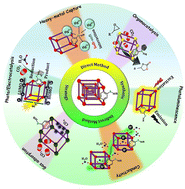Thiol and thioether-based metal–organic frameworks: synthesis, structure, and multifaceted applications
Abstract
Metal–organic frameworks (MOFs) are unique hybrid porous materials formed by combining metal ions or clusters with organic ligands. Thiol and thioether-based MOFs belong to a specific category of MOFs where one or many thiols or thioether groups are present in organic linkers. Depending on the linkers, thiol-thioether MOFs can be divided into three categories: (i) MOFs where both thiol or thioether groups are part of the carboxylic acid ligands, (ii) MOFs where only thiol or thioether groups are present in the organic linker, and (iii) MOFs where both thiol or thioether groups are part of azolate-containing linkers. MOFs containing thiol-thioether-based acid ligands are synthesized through two primary approaches; one is by utilizing thiol and thioether-based carboxylic acid ligands where the bonding pattern of ligands with metal ions plays a vital role in MOF formation (HSAB principle). MOFs synthesized by this approach can be structurally differentiated into two categories: structures without common structural motifs and structures with common structural motifs (related to UiO-66, UiO-67, UiO-68, MIL-53, NU-1100, etc.). The second approach to synthesize thiol and thioether-based MOFs is indirect methods, where thiol or thioether functionality is introduced in MOFs by techniques like post-synthetic modifications (PSM), post-synthetic exchange (PSE) and by forming composite materials. Generally, MOFs containing only thiol-thioether-based ligands are synthesized by interfacial assisted synthesis, forming two-dimensional sheet frameworks, and show significantly high conductivity. A limited study has been done on MOFs containing thiol-thioether-based azolate ligands where both nitrogen- and sulfur-containing functionality are present in the MOF frameworks. These materials exhibit intriguing properties stemming from the interplay between metal centres, organic ligands, and sulfur functionality. As a result, they offer great potential for multifaceted applications, ranging from catalysis, sensing, and conductivity, to adsorption. This perspective is organised through an introduction, schematic representations, and tabular data of the reported thiol and thioether MOFs and concluded with future directions.

- This article is part of the themed collection: 2023 Frontier and Perspective articles


 Please wait while we load your content...
Please wait while we load your content...